|
Geometric Tolerancing
|

|
Geometric Set Operations for Tolerancing in CAD
Principal Investigator: Johannes Wallner
Austrian Science Fund (FWF) project P15911
|
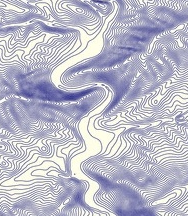
|
M. Hofer, G. Sapiro, and J. Wallner.
Fair polyline networks for
constrained smoothing of digital terrain elevation data.
IEEE Trans. Geosc. Remote Sensing 44/10/2 (2006), 2983-2990.
We present a framework which uses fair polyline networks
for smoothing digital terrain elevation data with guaranteed error
bounds and feature preservation. The algorithm is capable of
smoothing the terrain data with tolerance cylinders of different
sizes. These flexible tolerances have two advantages in
particular: (i) we can preserve features present in the data by
reducing the size of the tolerance cylinders in feature areas,
(ii) the algorithm can be used to fill holes present in the
original data during the smoothing process. Single contour lines
are smoothed via processing of a small neighborhood of that
contour line.
|
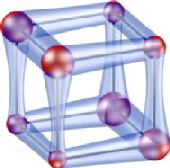
|
H.-P. Schröcker and J. Wallner:
Curvatures and Tolerances in the Euclidean Motion Group.
Results Math. 47 (2005), 132-146.
We investigate the action of imprecisely defined affine and
Euclidean transformations and compute tolerance zones of
points and subspaces. Tolerance zones in the Euclidean motion
group are analysed by means of linearisation and bounding the
linearisation error via the curvatures of that group with
respect to an appropriate metric.
|
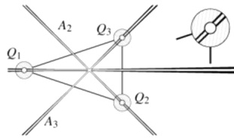
|
J. Wallner, H.-P. Schröcker, and S. Hu.
Tolerances
in geometric constraint problems.
Reliab. Comput. 11, 234-251 (2005).
We study error propagation through implicit geometric problems by linearising and estimating the linearisation error. The method is particularly useful for quadratic constraints, which turns out to be no big restriction for many geometric problems in applications.
|
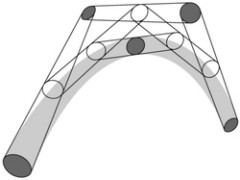
|
J. Wallner, R. Krasauskas,, H. Pottmann:
Error Propagation in Geometric Constructions,
Computer-Aided Design 32 (2000), 631-641.
In this paper we consider error propagation in geometric constructions from a geometric viewpoint. First we study affine combinations of convex bodies: This has numerous examples in spline curves and surfaces defined by control points. Second, we study in detail the circumcircle of three points in the Euclidean plane. It turns out that the right geometric setting for this problem is Laguerre geometry and the cyclographic mapping, which provides a point model for sets of circles or spheres.
|
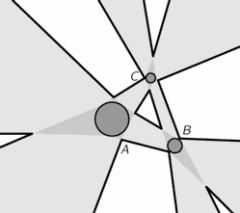
|
H. Pottmann, B. Odehnal, M. Peternell, J. Wallner, R. Ait Haddou: On optimal tolerancing in Computer-Aided Design In: R. Martin and W. Wang, eds., Geometric Modeling and Processing 2000, IEEE Computer Society, Los Alamitos, CA, 2000, pp. 347-363.
A geometric approach to the computation of precise or well approximated tolerance zones for CAD constructions is given. We continue a previous study of linear constructions and freeform curve and surface schemes under the assumption of convex tolerance regions for points. The computation of the boundaries of the tolerance zones for curves and surfaces is discussed. We also study congruence transformations in the presence of errors and families of circles arising in metric constructions under the assumption of tolerances in the input. The classical cyclographic mapping as well as ideas from convexity and classical differential geometry appear as central geometric tools.
|
|
|
Publications
-
J. Wallner.
Note on curve
and surface energies.
Technical Report 151, Geometry Preprint Series, Vienna Univ. of Technology,
December 2005.
-
M. Hofer, G. Sapiro, and J. Wallner.
Fair polyline networks for
constrained smoothing of digital terrain elevation data.
IEEE Trans. Geosc. Remote Sensing 44/10/2 (2006), 2983-2990.
-
Q.-M. Yang and J. Wallner.
Asymptotic analysis of implicit tolerance
problems.
Math. Pannon. 16/2 (2005), 263-285.
[MR].
-
Q.-M. Yang.
Geometric contributions to tolerance analysis.
PhD thesis, Vienna University of Technology, 2005.
Advisor: J. Wallner.
-
J. Wallner and Q.-M. Yang.
Swept volumes of many poses.
In M. Desbrun and H. Pottmann, editors, SGP 2005: Third Eurographics
Symposium on Geometry processing, pages 161-170. Eurographics
Association, 2005, ISBN 3-905673-24-X.
-
H.-P. Schröcker and J. Wallner.
Geometric
constructions with discretized random variables.
Reliab. Comput. 12/3 (2006), 203-223.
-
H.-P. Schröcker and J. Wallner.
Curvatures and tolerances in the Euclidean motion group.
Results Math. 47 (2005), 132-146.
[MR].
-
S.-M. Hu and J. Wallner.
A second order
algorithm for orthogonal projection onto curves and surfaces.
Comput. Aided Geom. Design 22/3 (2005), 251-260.
[MR].
-
J. Wallner, H.-P. Schröcker, and S.-M. Hu.
Tolerances in geometric constraint
problems.
Reliab. Comput. 11 (2005), 235-251.
[MR].
-
J. Wallner.
On a problem of
elementary differential geometry and the number of its solutions.
Technical Report 106, Institute of Geometry, September 2003.
-
S.-M. Hu and J. Wallner.
Error propagation through geometric transformations.
J. Geom. Graphics 8/2 (2004), 171-183.
[MR].
-
J. Wallner.
Existence of
set-interpolating and energy-minimizing curves.
Technical Report 111, Institute of Geometry, 2003-2004.
-
H. Pottmann, B. Odehnal, M. Peternell, J. Wallner, and R. Ait Haddou.
On optimal tolerancing in Computer-Aided Design.
In R. Martin and W. Wang, editors, Geometric Modeling and Processing
2000, pages 347-363. IEEE Computer Society, Los Alamitos, Calif., 2000,
ISBN 0-7695-0562-7.
-
J. Wallner, R. Krasauskas, and H. Pottmann.
Error propagation in geometric constructions.
Computer-Aided Design 32 (2000), 631-641.
|
|
|
Quick Links
Boris Odehnal
Hans-Peter Schröcker
Johannes Wallner
Discrete Differential Geometry
Developable Surfaces
Nonlinear Subdivision
Geometric Spline Theory
Sitemap
External Links

Austrian Science Fund (FWF)
|


